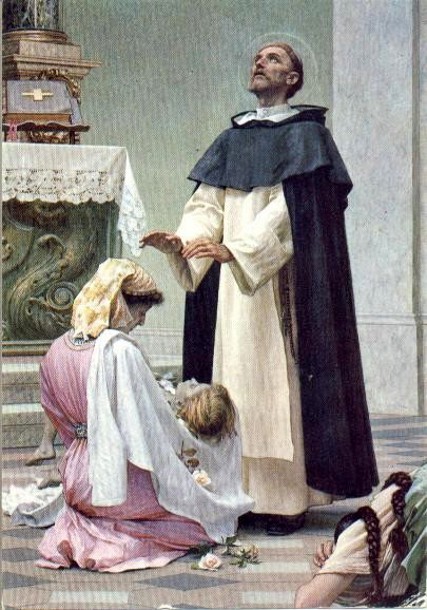
Vatican Radio REPORT:
Prayer, says Pope Benedict is our personal contact with God. Only this real,
constant relationship gives us the strength to live every event, especially the
most suffered moments of our lives. He urged people not to ‘takes holidays’ from
their daily conversation with God, even if in an increasingly frenetic world it
is difficult to find the time, the space and the right concentration for prayer.
Instead, the Pope suggested Wednesday, we should learn from St Dominic Guzman,
whose spiritual life inspired The Nine Ways of Prayer – basically a step
by step guide to prayer, from our physical attitude before the Lord to our
ability to orientate our whole person towards God.
Inspired by the liturgical feast of the founder of the Order of Preachers, August 8th, Pope Benedict returned for a second time during his general audience to this 13th Century Saint. He spoke to the pilgrims gathered in Castel Gandolfo’s “Freedom Square” of how St. Dominic’s apostolic zeal was energized by his intense life of prayer.
“St. Dominic reminds us of the importance of external attitudes in our prayers. That to kneel, to stand before the Lord, to fix our gaze on the Crucifix, to pause and gather ourselves in silence, is not a secondary act, but helps to us to place ourselves, our whole person, in relation to God. Once again, I would like draw attention to the need to find moments to pray quietly everyday for our spiritual life, we particularly have to take this time for ourselves during our vacation, to have time for this attempt to talk with God. This is also a way to help those who are near to us to enter into the luminous rays of the presence of God, who brings the peace and love that we all need”.Below a Vatican Radio translation of the Holy Father’s general audience catechesis
Dear brothers and sisters,
Today the Church celebrates the memory of St. Dominic de Guzman, priest and founder of the Order of Preachers, the Dominicans. In a previous catechesis, I already illustrated this noble figure and the vital contribution he made to the renewal of the Church of his time. Today, I would like to bring to light an essential aspect of spirituality: his life of prayer. St. Dominic was a man of prayer. In love with God, his only aspiration was the salvation of souls, especially those who, at the time, had fallen into heresy; in imitation of Christ, he radically embodied the three evangelical counsels uniting the proclamation of the Word with witness to a life of poverty, under the guidance of the Holy Spirit, he progressed along the path of Christian perfection. In every moment, prayer was the force that renewed and rendered fruitful his apostolic works.
Blessed Jordan of Saxony (who died in 1237), his successor as head of the Order, thus writes: "During the day, no-one was more sociable than he…conversely at night, no one more diligent in keeping vigil in prayer. He devoted his days to others, but the night he gave to God "(P. Filippini, Domenico visto dai suoi contemporanei, Bologna 1982, p 133). In St. Dominic we can see an example of the harmonious integration of contemplation of the divine mysteries and apostolic activity. According to the testimonies of those closest to him, "he always spoke with God or of God." This observation indicates his deep communion with the Lord and at the same time, a continued commitment to lead others to this communion with God. He did not leave writings on prayer, but the Dominican tradition collected and handed down his living experience in a work entitled: The Nine Ways of Prayer of St. Dominic. This was composed between 1260 and 1288 by a Dominican friar, it helps us to understand something of the Saint’s inner life, it also helps us in all our differences to learn something about how to pray.
There are therefore, nine ways of praying according to the Saint, and each of these was always carried out in front of Jesus Crucified, and express a corporal and spiritual attitude, that intimately interpenetrating, favor recollection and fervor. The first seven ways follow an ascending line, like the steps of a journey, towards an intimate communion with God, with the Trinity: St. Dominic prayed standing, bowing to express humility, lying prostrate on the ground to ask forgiveness for his sins, on his knees in penance to participate in the sufferings of the Lord, with his arms open staring at the crucifix to contemplate the Supreme Love, with his gaze directed towards the heavens feeling himself drawn towards the world of God. Therefore there are three forms, standing, on ones’ knees, lying prostrate on the ground, but always with our gaze toward the Crucified Lord.
However, I would like to pause briefly on the last two ways which correspond to two forms of piety that the Saint normally practiced. First, personal meditation, where prayer acquires a more intimate, fervent and soothing dimension. At the end of the recitation of the Liturgy of the Hours, and after the celebration of Mass, St. Dominic prolonged his conversation with God, without any time limits. He would sit in an attitude of quite recollection and listening, reading a book or staring at the Crucifix. He lived these moments of his relationship with God so intensely that his reactions of joy or tears were outwardly perceptible. Thus he assimilated this through the reality of faith. Witnesses say that at times he would go into a sort of ecstasy, his face transfigured, but immediately afterwards he would humbly resume his daily activities recharged by the power that comes from on High. Then prayer while traveling between one monastery or another, he would recite Lauds, Sext, Vespers with companions, and, crossing the valleys and hills, contemplate the beauty of creation. At such times a hymn of praise and thanksgiving to God for so many gifts would gush from his heart, especially for the greatest wonder of all: the redemption accomplished by Christ.
Dear friends, St. Dominic reminds us that at the origin of witnessing to the faith, which every Christian should give in the family, at work, in society, and even in moments of relaxation, is prayer, a personal contact with God; only this real relationship with God gives us the strength to live every event, especially the most suffered moments, intensely. This saint reminds us of the importance of external attitudes in our prayers. That to kneel, to stand before the Lord, to fix our gaze on the Crucifix, to pause and gather ourselves in silence, is not a secondary act, but helps to us to place ourselves, our whole person, in relation to God. Once again, I would like draw attention to the need to find moments to pray quietly everyday for our spiritual life, we particularly have to take this time for ourselves during our vacation, to have time for this attempt to talk with God. This is also a way to help those who are near to us to enter into the luminous rays of the presence of God, who brings the peace and love that we all need.
SHARED FROM RADIO VATICANA
Inspired by the liturgical feast of the founder of the Order of Preachers, August 8th, Pope Benedict returned for a second time during his general audience to this 13th Century Saint. He spoke to the pilgrims gathered in Castel Gandolfo’s “Freedom Square” of how St. Dominic’s apostolic zeal was energized by his intense life of prayer.
“St. Dominic reminds us of the importance of external attitudes in our prayers. That to kneel, to stand before the Lord, to fix our gaze on the Crucifix, to pause and gather ourselves in silence, is not a secondary act, but helps to us to place ourselves, our whole person, in relation to God. Once again, I would like draw attention to the need to find moments to pray quietly everyday for our spiritual life, we particularly have to take this time for ourselves during our vacation, to have time for this attempt to talk with God. This is also a way to help those who are near to us to enter into the luminous rays of the presence of God, who brings the peace and love that we all need”.Below a Vatican Radio translation of the Holy Father’s general audience catechesis
Dear brothers and sisters,
Today the Church celebrates the memory of St. Dominic de Guzman, priest and founder of the Order of Preachers, the Dominicans. In a previous catechesis, I already illustrated this noble figure and the vital contribution he made to the renewal of the Church of his time. Today, I would like to bring to light an essential aspect of spirituality: his life of prayer. St. Dominic was a man of prayer. In love with God, his only aspiration was the salvation of souls, especially those who, at the time, had fallen into heresy; in imitation of Christ, he radically embodied the three evangelical counsels uniting the proclamation of the Word with witness to a life of poverty, under the guidance of the Holy Spirit, he progressed along the path of Christian perfection. In every moment, prayer was the force that renewed and rendered fruitful his apostolic works.
Blessed Jordan of Saxony (who died in 1237), his successor as head of the Order, thus writes: "During the day, no-one was more sociable than he…conversely at night, no one more diligent in keeping vigil in prayer. He devoted his days to others, but the night he gave to God "(P. Filippini, Domenico visto dai suoi contemporanei, Bologna 1982, p 133). In St. Dominic we can see an example of the harmonious integration of contemplation of the divine mysteries and apostolic activity. According to the testimonies of those closest to him, "he always spoke with God or of God." This observation indicates his deep communion with the Lord and at the same time, a continued commitment to lead others to this communion with God. He did not leave writings on prayer, but the Dominican tradition collected and handed down his living experience in a work entitled: The Nine Ways of Prayer of St. Dominic. This was composed between 1260 and 1288 by a Dominican friar, it helps us to understand something of the Saint’s inner life, it also helps us in all our differences to learn something about how to pray.
There are therefore, nine ways of praying according to the Saint, and each of these was always carried out in front of Jesus Crucified, and express a corporal and spiritual attitude, that intimately interpenetrating, favor recollection and fervor. The first seven ways follow an ascending line, like the steps of a journey, towards an intimate communion with God, with the Trinity: St. Dominic prayed standing, bowing to express humility, lying prostrate on the ground to ask forgiveness for his sins, on his knees in penance to participate in the sufferings of the Lord, with his arms open staring at the crucifix to contemplate the Supreme Love, with his gaze directed towards the heavens feeling himself drawn towards the world of God. Therefore there are three forms, standing, on ones’ knees, lying prostrate on the ground, but always with our gaze toward the Crucified Lord.
However, I would like to pause briefly on the last two ways which correspond to two forms of piety that the Saint normally practiced. First, personal meditation, where prayer acquires a more intimate, fervent and soothing dimension. At the end of the recitation of the Liturgy of the Hours, and after the celebration of Mass, St. Dominic prolonged his conversation with God, without any time limits. He would sit in an attitude of quite recollection and listening, reading a book or staring at the Crucifix. He lived these moments of his relationship with God so intensely that his reactions of joy or tears were outwardly perceptible. Thus he assimilated this through the reality of faith. Witnesses say that at times he would go into a sort of ecstasy, his face transfigured, but immediately afterwards he would humbly resume his daily activities recharged by the power that comes from on High. Then prayer while traveling between one monastery or another, he would recite Lauds, Sext, Vespers with companions, and, crossing the valleys and hills, contemplate the beauty of creation. At such times a hymn of praise and thanksgiving to God for so many gifts would gush from his heart, especially for the greatest wonder of all: the redemption accomplished by Christ.
Dear friends, St. Dominic reminds us that at the origin of witnessing to the faith, which every Christian should give in the family, at work, in society, and even in moments of relaxation, is prayer, a personal contact with God; only this real relationship with God gives us the strength to live every event, especially the most suffered moments, intensely. This saint reminds us of the importance of external attitudes in our prayers. That to kneel, to stand before the Lord, to fix our gaze on the Crucifix, to pause and gather ourselves in silence, is not a secondary act, but helps to us to place ourselves, our whole person, in relation to God. Once again, I would like draw attention to the need to find moments to pray quietly everyday for our spiritual life, we particularly have to take this time for ourselves during our vacation, to have time for this attempt to talk with God. This is also a way to help those who are near to us to enter into the luminous rays of the presence of God, who brings the peace and love that we all need.
SHARED FROM RADIO VATICANA
NOVENA TO OUR LADY : OFFICIAL FOR ASSUMPTION FEAST - PLENARY INDULGENCE - DAY 3
OFFICIAL RACCOLTA NOVENA PRAYER WITH INDULGENCE:
V. Emitte Spiritum tuum, et creabuntur.
R. Et renovabis faciem terrae.
Oremus.
Deus, qui corda fidelium Sancti Spiritus illustratione docuisti: da nobis in eodem Spiritu recta sapere, et de ejus semper consolatione gaudere. Per Christum Dominum nostrum. R. Amen.
TRANSLATION.
Come, Holy Spirit, fill the hearts of Thy faithful, and kindle in them the fire of Thy love.
V. Send forth Thy Spirit, and they shall be created.
R. And Thou shalt renew the face of the earth.
Let us pray.
O God, who hast taught the hearts of Thy faithful people by the light of the Holy Spirit; grant us in the same Spirit to relish what is right, and evermore to rejoice in his holy comfort. Through Christ our Lord. R. Amen.
HYMN.
O gloriosa Virginum,
Sublimis inter sidera,
Qui te creavit, parvulum
Lactente nutris ubere.
Quod Heva tristis abstulit,
Tu reddis almo germine:
Intrent ut astra flebiles,
Coeli recludis cardines.
Tu regis alti janua,
Et aula lucis fulgida:
Vitam datam per Virginem,
Gentes redemptae plaudite.
Jesu, tibi sit gloria,
Qui natus es de Virgine,
Cum Patre, et almo Spiritu
In sempiterna saecula. Amen.
TRANSLATION.
O Queen of all the Virgin choir,
Enthroned above the starry sky;
Who with pure milk from thy own breast
Thy own Creator didst supply.
What man hath lost in hapless Eve,
Thy sacred womb to man restores;
Thou to the sorrowing here beneath
Hast open’d Heaven’s eternal doors.
Hail, O refulgent Hall of light!
Hail, Gate sublime of Heaven’s high King!
Through thee redeem’d to endless life,
Thy praise let all the nations sing.
O Jesu! born of Virgin bright,
Immortal glory be to Thee;
Praise to the Father infinite,
And Holy Ghost eternally.
GLORY OF MARY IN DEATH.
She died in an ecstasy of love.
Let us meditate how glorious the most holy Mary was in her death, because she died of a very ecstasy of the love of God; and desiring that we too may be strengthened by that holy fire of love, let us ask for her help:
i. Mary, most happy Virgin, who didst die of the vehemence of thy love of God; make it thy care that in our hearts, as God doth will, there be lit up this living fire of His love.
Three Ave Maria’s.
ii. Mary, most happy Virgin, who dying of divine love didst teach us what our love of God ought to do; pray for us, that we may never leave our God in life or death.
Three Ave Marias.
iii. Mary, most happy Virgin, who in leaving this mortal life by virtue of an ecstasy of love didst make known the fire which ever burnt within thy heart; obtain for us at least a spark of that same fire, to give us true sorrow for our sins.
Three Ave Marias.
Let us with the third choir of angels now exalt the ineffable glory of Mary, inflamed with the love of her God, and say with her: The Litany of Our Lady :
V. Exaltata est Sancta Dei
Genitrix.
R. Super choros angelorum ad coelestia regna.
Oremus.
Famulorum tuorum, quaesumus Domine, delictis ignosce: ut qui tibi placere de actibus nostris non valemus, Genitricis Filii tui Domini nostri intercessione salvemur.
Oremus.
Deus, qui corda fidelium Sancti Spiritus illustratione docuisti: da nobis in eodem Spiritu recta sapere, et de ejus semper consolatione gaudere. Per Christum Dominum nostrum. R. Amen
TRANSLATION.
V. The holy Mother of God is exalted.
R. Into the heavenly kingdom above the angel choirs.
Let us pray.
We beseech thee, Lord, pardon the shortcomings of Thy servants; that we who by our own works are not able to please Thee, may be saved by the intercession of the Mother of thy Son our Lord Jesus Christ.. Who, & c.
Let us pray.
O God, who hast taught the hearts of Thy faithful people by the light of the Holy Spirit; grant us in the same Spirit to relish what is right, and evermore to rejoice in his holy comfort. Through Christ our Lord. R. AMEN
To all faithful Christians who, in private or public, in
church or in their own houses, shall keep any of the following Novenas, in
preparation for the principal feasts of most holy Mary, Pope Pius VII., at the
prayer of several holy persons, granted, by Rescripts issued through his
Eminence the Cardinal-Vicar, Aug. 4 and Nov. 24, 1808, and Jan. 11, 1800 (all of
which are kept in the Segretaria of the Vicariate) -
i. An indulgence of 300 days, daily.
ii. A plenary indulgence to all who shall assist at these Novenas every day, and who shall afterwards, either on the Feast-day itself, to which each Novena respectively has reference, or on some one day in its Octave, after Confession and Communion, pray to our Lord and to the Blessed Virgin ac cording to the pious intention of the Sovereign Pontiff.
Veni Sancte Spiritus, reple tuorum corda fidelium,
et tui amoris in eis ignem accende.i. An indulgence of 300 days, daily.
ii. A plenary indulgence to all who shall assist at these Novenas every day, and who shall afterwards, either on the Feast-day itself, to which each Novena respectively has reference, or on some one day in its Octave, after Confession and Communion, pray to our Lord and to the Blessed Virgin ac cording to the pious intention of the Sovereign Pontiff.
V. Emitte Spiritum tuum, et creabuntur.
R. Et renovabis faciem terrae.
Oremus.
Deus, qui corda fidelium Sancti Spiritus illustratione docuisti: da nobis in eodem Spiritu recta sapere, et de ejus semper consolatione gaudere. Per Christum Dominum nostrum. R. Amen.
TRANSLATION.
Come, Holy Spirit, fill the hearts of Thy faithful, and kindle in them the fire of Thy love.
V. Send forth Thy Spirit, and they shall be created.
R. And Thou shalt renew the face of the earth.
Let us pray.
O God, who hast taught the hearts of Thy faithful people by the light of the Holy Spirit; grant us in the same Spirit to relish what is right, and evermore to rejoice in his holy comfort. Through Christ our Lord. R. Amen.
HYMN.
O gloriosa Virginum,
Sublimis inter sidera,
Qui te creavit, parvulum
Lactente nutris ubere.
Quod Heva tristis abstulit,
Tu reddis almo germine:
Intrent ut astra flebiles,
Coeli recludis cardines.
Tu regis alti janua,
Et aula lucis fulgida:
Vitam datam per Virginem,
Gentes redemptae plaudite.
Jesu, tibi sit gloria,
Qui natus es de Virgine,
Cum Patre, et almo Spiritu
In sempiterna saecula. Amen.
TRANSLATION.
O Queen of all the Virgin choir,
Enthroned above the starry sky;
Who with pure milk from thy own breast
Thy own Creator didst supply.
What man hath lost in hapless Eve,
Thy sacred womb to man restores;
Thou to the sorrowing here beneath
Hast open’d Heaven’s eternal doors.
Hail, O refulgent Hall of light!
Hail, Gate sublime of Heaven’s high King!
Through thee redeem’d to endless life,
Thy praise let all the nations sing.
O Jesu! born of Virgin bright,
Immortal glory be to Thee;
Praise to the Father infinite,
And Holy Ghost eternally.
GLORY OF MARY IN DEATH.
She died in an ecstasy of love.
Let us meditate how glorious the most holy Mary was in her death, because she died of a very ecstasy of the love of God; and desiring that we too may be strengthened by that holy fire of love, let us ask for her help:
i. Mary, most happy Virgin, who didst die of the vehemence of thy love of God; make it thy care that in our hearts, as God doth will, there be lit up this living fire of His love.
Three Ave Maria’s.
ii. Mary, most happy Virgin, who dying of divine love didst teach us what our love of God ought to do; pray for us, that we may never leave our God in life or death.
Three Ave Marias.
iii. Mary, most happy Virgin, who in leaving this mortal life by virtue of an ecstasy of love didst make known the fire which ever burnt within thy heart; obtain for us at least a spark of that same fire, to give us true sorrow for our sins.
Three Ave Marias.
Let us with the third choir of angels now exalt the ineffable glory of Mary, inflamed with the love of her God, and say with her: The Litany of Our Lady :
| Lord,
have mercy on us. (Christ have mercy on us.) Lord, have mercy on us. Christ, hear us. (Christ graciously hear us.) God, the Father of heaven, (have mercy on us.) God the Son, Redeemer of the world, (have mercy on us.) God the Holy Ghost, (have mercy on us.) Holy Trinity, one God, (have mercy on us.) | |
| Holy
Mary, Holy Mother of God, Holy Virgin of virgins, Mother of Christ, Mother of the Church Mother of divine grace, Mother most pure, Mother most chaste, Mother inviolate, Mother undefiled, Mother most amiable, Mother most admirable, Mother of good counsel, Mother of our Creator, Mother of our Savior, Virgin most prudent, Virgin most venerable, Virgin most renouned, Virgin most powerful, Virgin most merciful, Virgin most faithful, Mirror of justice, Seat of wisdom, Cause of our joy, Spiritual vessel, Vessel of honor, Singular vessel of devotion, Mystical rose, Tower of David, Tower of ivory, House of gold, Ark of the covenant, Gate of heaven, Morning star, Health of the sick, Refuge of sinners, Comforter of the afflicted, Help of Christians, Queen of Angels, Queen of Patriarchs, Queen of Prophets, Queen of Apostles, Queen of Martyrs, Queen of Confessors, Queen of Virgins, Queen of all Saints, Queen conceived without original sin, Queen assumed into heaven, Queen of the most holy Rosary. Queen of the family, Queen of Peace, |
p
r a y f o r u s |
Lamb
of God, who takest away the sins of the world, (spare us, O
Lord.)
Lamb of God, who takest away the sins of the world, (graciously hear us O Lord.) Lamb of God, who takest away the sins of the world, (have mercy on us.) Pray for us, O holy Mother of God. (That we may be made worthy of the promises of Christ.) Let us pray. Grant, we beseech Thee, O Lord God, unto us Thy servants, that we may rejoice in continual health of mind and body; and, by the glorious intercession of Blessed Mary ever Virgin, may be delivered from present sadness, and enter into the joy of Thine eternal gladness. Through Christ our Lord. (Amen.) | |
R. Super choros angelorum ad coelestia regna.
Oremus.
Famulorum tuorum, quaesumus Domine, delictis ignosce: ut qui tibi placere de actibus nostris non valemus, Genitricis Filii tui Domini nostri intercessione salvemur.
Oremus.
Deus, qui corda fidelium Sancti Spiritus illustratione docuisti: da nobis in eodem Spiritu recta sapere, et de ejus semper consolatione gaudere. Per Christum Dominum nostrum. R. Amen
TRANSLATION.
V. The holy Mother of God is exalted.
R. Into the heavenly kingdom above the angel choirs.
Let us pray.
We beseech thee, Lord, pardon the shortcomings of Thy servants; that we who by our own works are not able to please Thee, may be saved by the intercession of the Mother of thy Son our Lord Jesus Christ.. Who, & c.
Let us pray.
O God, who hast taught the hearts of Thy faithful people by the light of the Holy Spirit; grant us in the same Spirit to relish what is right, and evermore to rejoice in his holy comfort. Through Christ our Lord. R. AMEN
DONATE NOW VIA PAYPAL
AMERICA : KNIGHTS OF COLUMBUS CONVENTION - RECORD BREAKING DONATIONS
AUSTRALIA : 103 RD ANNIVERSARY OF ST. MARY MACKILLOP
Catholic Communications, Sydney Archdiocese
REPORT
7 Aug 2012
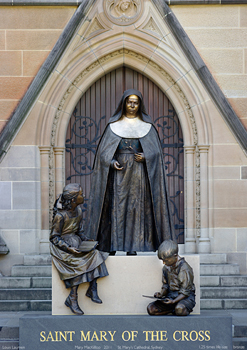
Wednesday August 8 marks the
103rd anniversary of the death of Mary MacKillop and the second Feast Day of
Australia's first Saint.
Canonised by Pope John Paul II on 17 October 2010, Saint Mary of the Cross MacKillop's Feast Day will be celebrated not only at schools, parishes and churches across Australia but by communities and individuals worldwide.
Although her death occurred more than a century ago, she continues to inspire men, women and children whether Catholic or non-Catholic.
Her Feast Day, which was declared a Solemnity by the Vatican at the request of the Australian Catholic Bishops Conference last year, is also a time to contemplate her remarkable life, her sense of social justice and her enormous contribution to education and as a champion of the poor, vulnerable and marginalised.
But while most Australians know Mary MacKillop's name many are unaware of exactly what this compassionate, devout and determined young woman achieved in her lifetime or why she remains such an inspiration, not only to Australians but to men and women worldwide.
The co-founder of the Josephites, the Sisters of St Joseph of the Sacred Heart, she was a tireless advocate of education and schools. At just 24 she established a school for children of the poor and underprivileged in Penola, SA, and under her guidance, her Order went on to found schools not only across SA but also in Victoria, NSW and eventually New Zealand.
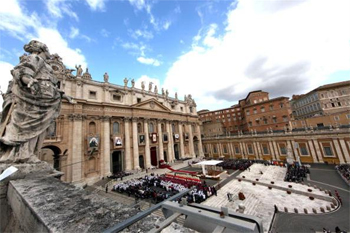
St Mary and her Sisters were also
responsible for setting up orphanages and homes for the destitute as well as
establishing refuges for ex-inmates of Australia's grim nineteenth century
prisons. She also set up shelters for former prostitutes earning criticism and
outrage from the city fathers who believed giving aid to prostitutes, reformed
or otherwise, was beyond the pale.
In a world of strait-laced Victorians as well as a male-dominated Church, St Mary's unwavering commitment to those on the margins of society constantly met with opposition. Antagonism to what she was trying to achieve came not only from the general public but from many of Australia's Irish-born Bishops. But with her strength of faith in God and her vision of a better world for all, St Mary refused to be daunted. With patience, a forgiving heart and trust in God, she managed to overcome whatever obstacles were put her way.
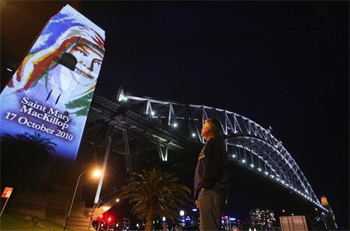
Born in Brunswick Street, Fitzroy
in Melbourne in1842, St Mary was the eldest of eight children, the daughter of
Scottish-born immigrants Alexander and Flora MacKillop. The son of prosperous
parents, Alexander had studied for the priesthood in Rome but due to ill health
had been unable to continue with his studies. Returning to Scotland he sailed
for Australia with his parents. In Melbourne he met and married fellow Scot,
Flora McDonald but unlike his father, Alexander was financially inept and his
family was often without a home and had to frequently rely on the generosity of
friends and relatives.
Well-schooled himself, St Mary's father was a strong believer in education and when Mary's education at private schools had to be abandoned when he lost all his savings in a failed business venture, he took over as her teacher and chief educator.
A brilliant horsewoman and teacher
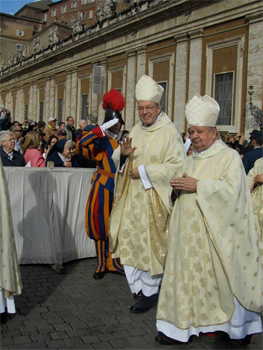
From an early age, St Mary was the
mainstay of the family. Kind, patient and mature beyond her years, she had an
instinctive compassion and selflessness. At just four years of age, noticing her
mother flagging with tiredness as they clambered up a hill, she offered her arm
to assist her. At eight, St Mary was caring for five younger brothers and
sisters who regarded her as their second mother, and by the time she was 10 she
had taken over the care of Flora's latest newborn when the nurse employed to
help with the family turned out to be a drunk.
Joining the workforce at 16 to help with the upkeep of her large poverty-stricken family, St Mary quickly proved herself as a hard worker and her employees, Sands and Kenny (now Sands & MacDougall), a printing and stationary company, paid her a forewoman's salary and gave her considerable responsibility and trust.
A year or two later, offered the job of governess to young cousins at her Uncle Cameron's extensive property at Penola in South Australia, teenage St Mary showed her aptitude not only as a teacher but as a horsewoman. Having inherited her mother's skills with horses, she could handle virtually any mount, no matter how frisky, and frequently helped out with the cattle roundups.
In Penola, Mary took a young Aboriginal child under her wing. The little girl's father worked on the station and her mother had gone "walkabout." Distressed at the girl's neglected condition, Mary bathed and washed her, treated her sores, shampooed her hair and gave her religious instruction, convinced that everyone whatever their colour, religion or gender had a right to be accepted and valued, regardless of their position in society.
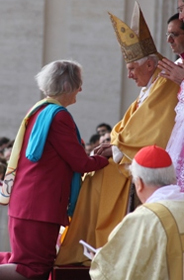
At 19, St Mary met Father Julian
Tenison Woods, the priest assigned to St Joseph's Church and the Penola Parish.
A talented missionary, musician, writer, scientist and lecturer, Fr Julian and
St Mary had similar ideas on education and their faith. When he told her he
needed help with the religious education of children in the outback, she
instantly volunteered. But with her family in Melbourne still dependent on her
income, at the eleventh hour she reluctantly had to turn him down and stay on as
governess to her uncle instead.
Nevertheless Fr Tenison Woods and St Mary remained on good terms and in 1866 these two enthusiastic educators founded the Sisters of St Joseph of the Sacred Heart.
Australia's first Sisters of St Joseph Schoolwith a mission to live in poverty and provide Catholic education to the children of the poor and needy as well as extending "an all-embracing charity" to the underprivileged and indigent, the Sisters of St Joseph was unlike any other order of the time, and was the first "Australian-made" congregation.
Unconstrained by normal convent strictures which were customary in Ireland and adopted by Church leaders in Australia, St Mary and the Sisters of St Joseph obtained Papal approval to move freely from diocese to diocese with St Mary rather than a Bishop of the local diocese in charge of the Sisters and their work.
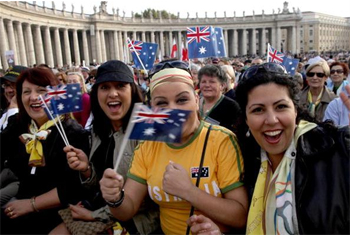
As the fledgling Congregation's
first member and its Mother Superior, St Mary took a vow of poverty, and donning
a simple brown habit opened her first school in a disused stable on March 19
1866 in Penola, SA.
News of what would later be known as the Woods MacKillop School, spread quickly and on hearing about St Mary's work, other young women came forward becoming Sisters of St Joseph as well as teachers at the school.
Within 12 months, the work of the Sisters of St Joseph had become so well known the newly-arrived Bishop of Adelaide, Irish-born Bishop Laurence Sheil, who had appointed Fr Julian Tenison Woods as his Director General of Catholic Education, asked St Mary and her Sisters to open a school in Adelaide.
Over the next four years, St Mary and the Sisters established 35 schools across the State as well as an orphanage, a women's refuge and a House of Providence for the homeless and abused.

But instead of being praised for
her work, the Bishop and Church leaders in Adelaide were upset by St Mary's
independence and the fact she and her Congregation were not under their control.
Fiercely conservative, the Bishop and Church leaders also objected to the Josephites' vow of poverty and practice of begging to fund their schools, shelters and orphanages.
Adelaide's Bishop Excommunicates Mary
In an attempt to wrest control of the Sisters and bring St Mary to heel, Father Keating and others spread rumours that she was a drinker. It is believed Father Keating was about to be exposed by the Josephites as a pedophile. But before this could happen, Bishop Sheil urged on by Keating and others in the Diocese, had St Mary excommunicated and thrown out of the Church for alleged insubordination. He then attempted to disband the Sisters.
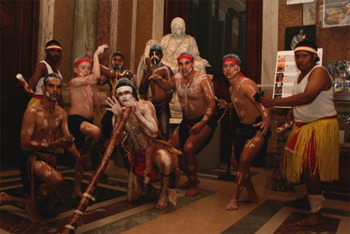
Devastated, 29-year-old St Mary
prayed to God, convinced her trust and belief in the Lord would sort out this
terrible turn of events. Forbidden to have contact with anyone in the Church,
she was given shelter by a Jewish family and received help and support from
South Australia's Jesuit priests.
Throughout this time she never lost her deep faith and trust in God. This was not misplaced and within five months, Bishop Sheil realising his error, retracted his statements and St Mary's membership of the Church restored.
Sheil died nine days later, but St Mary who harboured no grudges and never blamed the Bishop or Church for their actions either by word or in her writings, nevertheless decided to seek official sanction for the Congregation she had founded, and in 1873 travelled to Rome to seek Papal approval for the Sisters of St Mary of the Sacred Heart.
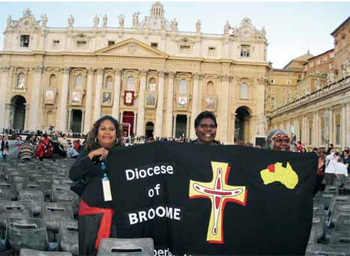
Pope Pius IX was impressed with St
Mary's intelligence and determination and the young woman used her time in
Europe to travel widely studying educational methods before returning to
Australia where under her direction, the Sisters expanded their work,
establishing schools throughout New South Wales as well as New Zealand.
Elected Superior General of the Order in 1875, St Mary decided to leave South Australia for Sydney in 1883 where she established the Sisters of St Joseph's Mother House at North Sydney. But it wasn't until 1888, 22 years after she had founded the Order that official approval of finally given by Pope Leo XIII.
Travelling extensively throughout Australasia over the next decade, St Mary founded convents, charitable institutions and free schools for children in Queensland, NSW, Victoria and SA as well as New Zealand, at time when most families had to pay to educate their children and only the wealthy could afford to send their children to school.
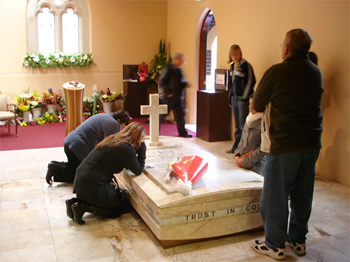
Filled with affection and a deep
love of children, St Mary radiated warmth and kindness matched with boundless
energy. Charismatic, she literally could light up a room and she became an
inspiration to almost everyone she met with her piety, humility and love of
life.
But in 1901, aged 59, she suffered a stroke while visiting Rotorua in New Zealand. Although she retained her mental acuity and vitality, she was now an invalid. Returning to Australia, she spent the remaining years of her life in Sydney.
"I have assisted at the deathbed of a saint."
Shortly before her death, she was visited by the Archbishop of Sydney, Cardinal Patrick Moran who said on leaving the Mother House of the Sisters of St Joseph: "I consider this day to have assisted at the deathbed of a saint."
St Mary died on Sunday August 8, 1909. Her funeral was held at St Mary's Catholic Church on Miller Street, North Sydney and attended by an enormous crowd. Four years later in 1913, the Mary MacKillop Memorial Chapel was built and now houses her tomb. It was here that Pope John Paul II prayed on his visit to Australia in 1995 shortly after announcing her Beatification setting her on the path towards Sainthood.
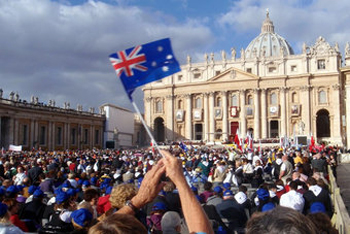
On his visit to Sydney in 2008,
Pope Benedict XVI also visited the Tomb in the tiny historic chapel at MacKillop
Place and described the selfless determined Australian as "one of the most
outstanding figures" in the nation's history, praising her for her perseverance
in the face of adversity and for her pleas for justice on behalf of the unfairly
treated.
"She was a practical example of holiness."
To be canonised, two miracles must be investigated and confirmed by the Vatican.
The first miracle, confirmed by the Church for Beatification, occurred in the 1960s when a woman with leukaemia was given only a few months to live. However when she asked the Sisters of St Joseph to pray to Mary MacKillop on her behalf and given a relic to wear, against all odds recovered from what had been diagnosed as an aggressive and fatal condition.
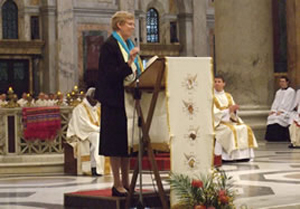
The second miracle, officially
approved by the Vatican in late 2009, concerned Kathleen Evans, a Hunter Valley
woman with inoperable lung cancer and secondaries to the liver. Sent home to
die, her family prayed to Mary MacKillop and not only did Kathleen recover but
when she saw her doctors all traces of her tumours and the cancer had
gone.
Today the Sisters of St Joseph can be found in all parts of the world working with the poor and in education, not just across Australia and New Zealand but in such far flung nations as East Timor, Peru, Canada, Scotland, Brazil and overseeing refugee camps in Uganda and Thailand.
To find out more about the work of the Sisters of St Joseph, and to download the liturgy specially written for the Feast Day of St Mary of the Cross MacKillop log on to www.sosj.org.au
SHARED FROM ARCHDIOCESE OF SYDNEY
7 Aug 2012

Louis Laumen's scupture of St Mary of the Cross
and children outside St Mary's Cathedral
Canonised by Pope John Paul II on 17 October 2010, Saint Mary of the Cross MacKillop's Feast Day will be celebrated not only at schools, parishes and churches across Australia but by communities and individuals worldwide.
Although her death occurred more than a century ago, she continues to inspire men, women and children whether Catholic or non-Catholic.
Her Feast Day, which was declared a Solemnity by the Vatican at the request of the Australian Catholic Bishops Conference last year, is also a time to contemplate her remarkable life, her sense of social justice and her enormous contribution to education and as a champion of the poor, vulnerable and marginalised.
But while most Australians know Mary MacKillop's name many are unaware of exactly what this compassionate, devout and determined young woman achieved in her lifetime or why she remains such an inspiration, not only to Australians but to men and women worldwide.
The co-founder of the Josephites, the Sisters of St Joseph of the Sacred Heart, she was a tireless advocate of education and schools. At just 24 she established a school for children of the poor and underprivileged in Penola, SA, and under her guidance, her Order went on to found schools not only across SA but also in Victoria, NSW and eventually New Zealand.

In a world of strait-laced Victorians as well as a male-dominated Church, St Mary's unwavering commitment to those on the margins of society constantly met with opposition. Antagonism to what she was trying to achieve came not only from the general public but from many of Australia's Irish-born Bishops. But with her strength of faith in God and her vision of a better world for all, St Mary refused to be daunted. With patience, a forgiving heart and trust in God, she managed to overcome whatever obstacles were put her way.

Well-schooled himself, St Mary's father was a strong believer in education and when Mary's education at private schools had to be abandoned when he lost all his savings in a failed business venture, he took over as her teacher and chief educator.
A brilliant horsewoman and teacher

Joining the workforce at 16 to help with the upkeep of her large poverty-stricken family, St Mary quickly proved herself as a hard worker and her employees, Sands and Kenny (now Sands & MacDougall), a printing and stationary company, paid her a forewoman's salary and gave her considerable responsibility and trust.
A year or two later, offered the job of governess to young cousins at her Uncle Cameron's extensive property at Penola in South Australia, teenage St Mary showed her aptitude not only as a teacher but as a horsewoman. Having inherited her mother's skills with horses, she could handle virtually any mount, no matter how frisky, and frequently helped out with the cattle roundups.
In Penola, Mary took a young Aboriginal child under her wing. The little girl's father worked on the station and her mother had gone "walkabout." Distressed at the girl's neglected condition, Mary bathed and washed her, treated her sores, shampooed her hair and gave her religious instruction, convinced that everyone whatever their colour, religion or gender had a right to be accepted and valued, regardless of their position in society.

Nevertheless Fr Tenison Woods and St Mary remained on good terms and in 1866 these two enthusiastic educators founded the Sisters of St Joseph of the Sacred Heart.
Australia's first Sisters of St Joseph Schoolwith a mission to live in poverty and provide Catholic education to the children of the poor and needy as well as extending "an all-embracing charity" to the underprivileged and indigent, the Sisters of St Joseph was unlike any other order of the time, and was the first "Australian-made" congregation.
Unconstrained by normal convent strictures which were customary in Ireland and adopted by Church leaders in Australia, St Mary and the Sisters of St Joseph obtained Papal approval to move freely from diocese to diocese with St Mary rather than a Bishop of the local diocese in charge of the Sisters and their work.

News of what would later be known as the Woods MacKillop School, spread quickly and on hearing about St Mary's work, other young women came forward becoming Sisters of St Joseph as well as teachers at the school.
Within 12 months, the work of the Sisters of St Joseph had become so well known the newly-arrived Bishop of Adelaide, Irish-born Bishop Laurence Sheil, who had appointed Fr Julian Tenison Woods as his Director General of Catholic Education, asked St Mary and her Sisters to open a school in Adelaide.
Over the next four years, St Mary and the Sisters established 35 schools across the State as well as an orphanage, a women's refuge and a House of Providence for the homeless and abused.

Fiercely conservative, the Bishop and Church leaders also objected to the Josephites' vow of poverty and practice of begging to fund their schools, shelters and orphanages.
Adelaide's Bishop Excommunicates Mary
In an attempt to wrest control of the Sisters and bring St Mary to heel, Father Keating and others spread rumours that she was a drinker. It is believed Father Keating was about to be exposed by the Josephites as a pedophile. But before this could happen, Bishop Sheil urged on by Keating and others in the Diocese, had St Mary excommunicated and thrown out of the Church for alleged insubordination. He then attempted to disband the Sisters.

Throughout this time she never lost her deep faith and trust in God. This was not misplaced and within five months, Bishop Sheil realising his error, retracted his statements and St Mary's membership of the Church restored.
Sheil died nine days later, but St Mary who harboured no grudges and never blamed the Bishop or Church for their actions either by word or in her writings, nevertheless decided to seek official sanction for the Congregation she had founded, and in 1873 travelled to Rome to seek Papal approval for the Sisters of St Mary of the Sacred Heart.

Elected Superior General of the Order in 1875, St Mary decided to leave South Australia for Sydney in 1883 where she established the Sisters of St Joseph's Mother House at North Sydney. But it wasn't until 1888, 22 years after she had founded the Order that official approval of finally given by Pope Leo XIII.
Travelling extensively throughout Australasia over the next decade, St Mary founded convents, charitable institutions and free schools for children in Queensland, NSW, Victoria and SA as well as New Zealand, at time when most families had to pay to educate their children and only the wealthy could afford to send their children to school.

But in 1901, aged 59, she suffered a stroke while visiting Rotorua in New Zealand. Although she retained her mental acuity and vitality, she was now an invalid. Returning to Australia, she spent the remaining years of her life in Sydney.
"I have assisted at the deathbed of a saint."
Shortly before her death, she was visited by the Archbishop of Sydney, Cardinal Patrick Moran who said on leaving the Mother House of the Sisters of St Joseph: "I consider this day to have assisted at the deathbed of a saint."
St Mary died on Sunday August 8, 1909. Her funeral was held at St Mary's Catholic Church on Miller Street, North Sydney and attended by an enormous crowd. Four years later in 1913, the Mary MacKillop Memorial Chapel was built and now houses her tomb. It was here that Pope John Paul II prayed on his visit to Australia in 1995 shortly after announcing her Beatification setting her on the path towards Sainthood.

"She was a practical example of holiness."
To be canonised, two miracles must be investigated and confirmed by the Vatican.
The first miracle, confirmed by the Church for Beatification, occurred in the 1960s when a woman with leukaemia was given only a few months to live. However when she asked the Sisters of St Joseph to pray to Mary MacKillop on her behalf and given a relic to wear, against all odds recovered from what had been diagnosed as an aggressive and fatal condition.

Today the Sisters of St Joseph can be found in all parts of the world working with the poor and in education, not just across Australia and New Zealand but in such far flung nations as East Timor, Peru, Canada, Scotland, Brazil and overseeing refugee camps in Uganda and Thailand.
To find out more about the work of the Sisters of St Joseph, and to download the liturgy specially written for the Feast Day of St Mary of the Cross MacKillop log on to www.sosj.org.au
SHARED FROM ARCHDIOCESE OF SYDNEY
AFRICA : SIERRA LEONE : BISHOPS - VOTE FOR THOSE WITH KEY GOSPEL VALUES
Agenzia Fides REPORT - The Bishops of Sierra Leone call on the
faithful to unity and commitment in political life in a Pastoral Letter
dedicated to the general election in November. The document, sent to Fides
Agency, recognizes "that the Church is involved in the political process but is
not partisan. In other words, the Church cannot champion the cause of any
candidate or political party.
" "Our cause" – continue the Bishops-is the defense of our Country and its citizens, inspired by fundamental moral principles which are essential for every authentic human living."
The Bishops therefore call the citizens to vote for leaders who they believe to be able "to represent and serve national interests to the best of their abilities", but warn that "while you exercise your democratic freedom to vote, it is important to judge a party on its overall policy regarding the key values of the Gospel such as promoting life, human dignity, justice, fostering peace and good governance." It also urges voters not to vote on the basis of tribal affiliation, regional or linguistic.
In the conclusive recommendations the Bishops call on Catholics to reject all forms of violence, the politicians to accept the election result and the police to remain neutral. (L.M.) (Agenzia Fides 07/08/2012)
" "Our cause" – continue the Bishops-is the defense of our Country and its citizens, inspired by fundamental moral principles which are essential for every authentic human living."
The Bishops therefore call the citizens to vote for leaders who they believe to be able "to represent and serve national interests to the best of their abilities", but warn that "while you exercise your democratic freedom to vote, it is important to judge a party on its overall policy regarding the key values of the Gospel such as promoting life, human dignity, justice, fostering peace and good governance." It also urges voters not to vote on the basis of tribal affiliation, regional or linguistic.
In the conclusive recommendations the Bishops call on Catholics to reject all forms of violence, the politicians to accept the election result and the police to remain neutral. (L.M.) (Agenzia Fides 07/08/2012)
ASIA : INDONESIA : HOUSE OF PRAYER CLOSED BY AUTHORITIES
ASIA NEWS REPORT: by Mathias
Hariyadi
Decision motivated by alleged irregularities in the building permit. The faithful respond: the documents are legal, the town council refuses to grant the permit. And promise to go ahead with regular Sunday services. For some time the area has been the scene of violence and abuse against minorities, especially Christians.
.jpg)
Jakarta (AsiaNews) - With the pretext of irregularities in building permits, public safety officials (the Satpol PP) in Bogor, West Java province, yesterday sealed off a "house of prayer" used by over 6 thousand Catholics from the parish of St. John the Baptist. For six years, the faithful have regularly used the building for weekend liturgies and those of the main Christian festivals, but had recently come under fire from authorities - three times - ordering them to stop all worship. The Catholic community has deliberately ignored the warnings, believing the closure order related IMB specious and counting on the legitimate right to religious freedom.
The process for building a church in Indonesia - Catholic or Protestant - is quite complicated and may take five to ten years to obtain all permits required by law. The procedure is governed by the Izin Mendirikan Bangunan (IMB), a species of written protocol that allows for construction to commence and is issued by local authorities. The story gets more complicated if it is a place of Christian worship: permission must be obtained from a number of residents in the area where the building is to be constructed and the local Group for Interfaith Dialogue. And even if the permission is granted "unspecified reasons" can come into play that will lead officials to block the projects. Often, this occurs after pressure from the Muslim community or radical Islamic movements.
The "house of prayer" is situated in Tulang Kuning, the village of Waru, in the Parung sub-district, Bogor regency. Yesterday a group of Satpol PP officers, led by Comerain La Ode, said the forced closure was "for the next seven days" and warned that "if the site is still used to pray in" teams would intervene to "demolish the building" .
However, local AsiaNews sources report that the Catholic community will not be intimidated and intend to hold their regular celebrations next weekend. "We have no alternative - said Fr. Gaib Pr, pastor of St. John the Baptist - but to gather in this place of prayer." He added that Catholics have fulfilled all the ritual procedures for obtaining building permits, but for years the Bogor administration refuses to grant any clearances.
Moreover, the authorities of the municipality of Bogor are not new to incidents of abuse and violence against other religions, particularly the Protestant Christian community that refers to the GKI Yasmin Church (YC), long a target of Mayor Diani Budiarto and his zealous officials, who have recently closed their place of worship on the same pretext. In the past, also, the area was the scene of anti-Christian violence especially during major holidays such as Christmas or Easter (see AsiaNews 23/12/2012 West Java: Islamic extremist groups threaten Catholics, Christmas celebrations at risk).
SHARED FROM ASIA NEWS IT
Decision motivated by alleged irregularities in the building permit. The faithful respond: the documents are legal, the town council refuses to grant the permit. And promise to go ahead with regular Sunday services. For some time the area has been the scene of violence and abuse against minorities, especially Christians.
.jpg)
Jakarta (AsiaNews) - With the pretext of irregularities in building permits, public safety officials (the Satpol PP) in Bogor, West Java province, yesterday sealed off a "house of prayer" used by over 6 thousand Catholics from the parish of St. John the Baptist. For six years, the faithful have regularly used the building for weekend liturgies and those of the main Christian festivals, but had recently come under fire from authorities - three times - ordering them to stop all worship. The Catholic community has deliberately ignored the warnings, believing the closure order related IMB specious and counting on the legitimate right to religious freedom.
The process for building a church in Indonesia - Catholic or Protestant - is quite complicated and may take five to ten years to obtain all permits required by law. The procedure is governed by the Izin Mendirikan Bangunan (IMB), a species of written protocol that allows for construction to commence and is issued by local authorities. The story gets more complicated if it is a place of Christian worship: permission must be obtained from a number of residents in the area where the building is to be constructed and the local Group for Interfaith Dialogue. And even if the permission is granted "unspecified reasons" can come into play that will lead officials to block the projects. Often, this occurs after pressure from the Muslim community or radical Islamic movements.
The "house of prayer" is situated in Tulang Kuning, the village of Waru, in the Parung sub-district, Bogor regency. Yesterday a group of Satpol PP officers, led by Comerain La Ode, said the forced closure was "for the next seven days" and warned that "if the site is still used to pray in" teams would intervene to "demolish the building" .
However, local AsiaNews sources report that the Catholic community will not be intimidated and intend to hold their regular celebrations next weekend. "We have no alternative - said Fr. Gaib Pr, pastor of St. John the Baptist - but to gather in this place of prayer." He added that Catholics have fulfilled all the ritual procedures for obtaining building permits, but for years the Bogor administration refuses to grant any clearances.
Moreover, the authorities of the municipality of Bogor are not new to incidents of abuse and violence against other religions, particularly the Protestant Christian community that refers to the GKI Yasmin Church (YC), long a target of Mayor Diani Budiarto and his zealous officials, who have recently closed their place of worship on the same pretext. In the past, also, the area was the scene of anti-Christian violence especially during major holidays such as Christmas or Easter (see AsiaNews 23/12/2012 West Java: Islamic extremist groups threaten Catholics, Christmas celebrations at risk).
SHARED FROM ASIA NEWS IT
TODAY'S MASS ONLINE : WEDNESDAY AUGUST 8, 2012
| Matthew
5: 13 - 16 | |
| 13 | "You are the salt of the earth; but if salt has lost its taste, how shall its saltness be restored? It is no longer good for anything except to be thrown out and trodden under foot by men. |
| 14 | "You are the light of the world. A city set on a hill cannot be hid. |
| 15 | Nor do men light a lamp and put it under a bushel, but on a stand, and it gives light to all in the house. |
| 16 | Let your light so shine before men, that they may see your good works and give glory to your Father who is in heaven. |
TODAY'S SAINT: AUG. 8: ST. DOMINIC
Founder of the Order of
Preachers, commonly known as the Dominican
Order; born at Calaroga, in Old
Castile, c. 1170; died 6 August, 1221. His parents,
Felix Guzman and Joanna of Aza, undoubtedly belonged to the nobility of Spain,
though probably neither was connected with the reigning house of Castile,
as some of the saint's
biographers assert. Of Felix Guzman, personally, little is known, except that he
was in every sense the worthy head of a family
of saints.
To nobility of blood Joanna of Aza added a nobility of soul
which so enshrined her in the popular veneration that in 1828 she was solemnly
beatified
by Leo
XII. The example of such parents
was not without its effect upon their children. Not only Saint Dominic but also
his brothers, Antonio and Manes, were distinguished for their extraordinary sanctity.
Antonio, the eldest, became a secular
priest and, having distributed his patrimony to the poor,
entered a hospital
where he spent his life ministering to the sick. Manes, following in the
footsteps of Dominic, became a Friar Preacher, and was beatified
by Gregory
XVI.
TODAY'S SAINT: AUG. 8: ST. MARY MACKILLOP
 ST. MARY MACKILLOP was born on January 15, 1842 and died on
August 8, 1909. She is also known as St. Mary of the Cross. She founded the
Sisters of St. Joseph of the Sacred Heart with Father Julian Tenison Woods. They
focus on education for the poor. She was canonized on October 17, 2010 by Pope
Benedict XVI. (Image: SQPN.com) She is the first Australian Canonized Saint.
Mary Helen MacKillop was born in Fitzroy, Victoria. Her parents lived in
Roybridge, Inverness-Shire, Scotland before their emigration to Australia. Her
father was Alexander MacKillop and her mother was Flora MacDonald. They arrived
in Melbourn in 1840. They had eight children: Margaret, 1843–1872, John 1845–1867, Annie 1848–1929,
Alexandrina 1850–1882, Donald 1853–1925, Alick died at 11 months and Peter
1857–1878. Mary was the eldest. Her brother Donald became a Jesuit priest and
her sister Alexandrina a nun. She was educated in private schools and became a
teacher. She went to Penola, in 1866, with her sisters Annie and Lexie to open
a Catholic school.
Fr. Woods was made
director of education and was the founder, along with MacKillop, of a school
they opened in a stable.
ST. MARY MACKILLOP was born on January 15, 1842 and died on
August 8, 1909. She is also known as St. Mary of the Cross. She founded the
Sisters of St. Joseph of the Sacred Heart with Father Julian Tenison Woods. They
focus on education for the poor. She was canonized on October 17, 2010 by Pope
Benedict XVI. (Image: SQPN.com) She is the first Australian Canonized Saint.
Mary Helen MacKillop was born in Fitzroy, Victoria. Her parents lived in
Roybridge, Inverness-Shire, Scotland before their emigration to Australia. Her
father was Alexander MacKillop and her mother was Flora MacDonald. They arrived
in Melbourn in 1840. They had eight children: Margaret, 1843–1872, John 1845–1867, Annie 1848–1929,
Alexandrina 1850–1882, Donald 1853–1925, Alick died at 11 months and Peter
1857–1878. Mary was the eldest. Her brother Donald became a Jesuit priest and
her sister Alexandrina a nun. She was educated in private schools and became a
teacher. She went to Penola, in 1866, with her sisters Annie and Lexie to open
a Catholic school.
Fr. Woods was made
director of education and was the founder, along with MacKillop, of a school
they opened in a stable.
In 1867, MacKillop became
Mother Superior of the new order Sisters of St Joseph of the Sacred Heart.
(Image Cultural Catholic.com) They moved to the convent in Adelaide. Since then
her order has grown and she is famous among Australians for her work.
Subscribe to: Posts (Atom)



